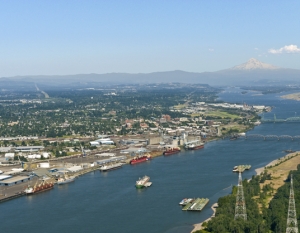


(Posted on 31/10/24)
The Port of Vancouver USA has announced it has been awarded a $22.5 million grant by the U.S. Environmental Protection Agency (EPA) for technologies that will enhance the port’s operational capabilities while reducing emissions.
From mineral ore to steel and aluminium, grain to wind turbine blades, the Port of Vancouver USA handles diverse bulk, break bulk, and project cargo for customers around the globe.
The award comes from the EPA’s Clean Ports Programme, established to help ports reduce emissions and benefit neighbouring communities through improved air quality.
“While the Port of Vancouver USA has been making strides to carry out our Climate Action Plan, this grant award represents a huge leap forward,” said Julianna Marler, CEO of the Port of Vancouver USA. “We’re grateful to the U.S. EPA and Senators Murray and Cantwell for creating and funding the Clean Ports Program that’s empowering ports like ours to accelerate a transformation to clean energy equipment and infrastructure. We appreciate the continued support of our entire federal delegation for their ongoing commitment to ports in our region.”
In addition to the grant award of $22,570,847, the port will contribute $2.5 million to purchase and deploy the following technologies:
? Two zero-emissions mobile harbor cranes. The port currently utilizes two diesel Liebherr mobile harbour cranes to move 80-meter wind blades, steel and aluminum, and other high and heavy cargo. The grant enables the port to purchase two zero-emissions electric Liebherr mobile harbour cranes that will offer increased lift capacity and expand the port’s cargo handling capabilities.
? Crane charging infrastructure. The port will install infrastructure capable of powering the new zero-emissions cranes via electric cable and battery.
? Shore power at Terminal 1. Once complete, the replacement of the port’s century-old dock at Terminal 1 will again allow it to welcome visitors from river cruises to Vancouver’s waterfront. This grant award enables the port to install shore power at Terminal 1, allowing cruise vessels to turn off diesel powered generators and plug in while docked in Vancouver.
The port began implementing its Climate Action Plan in 2021 to reduce greenhouse gas emissions while also improving air quality and health benefits in the community. The plan outlines specific actions for the port, including upgrading diesel- and gasoline-powered equipment, installing charging infrastructure and pursuing the use of shore power for vessels visiting the port.
Abu Dhabi based AD Ports Group, a global enabler of integrated trade, transport, industry, and logistics... Read more
This year marks a significant milestone in maritime innovation as Port Hedland, Australia, celebrates... Read more
Associated British Ports (ABP), the UK’s leading port operator, has announced the latest tranche... Read more
During the Investment, Labour, and Trade Promotion Programme in Japan (November 16–22, 2025),... Read more
AD Ports Group subsidiary Khalifa Economic Zones Abu Dhabi - KEZAD Group, the largest operator of integrated... Read more
Abu Dhabi based AD Ports Group, a global enabler of integrated trade, transport, industry, and logistics... Read more
Peel Ports Group has achieved a 48% reduction in operational greenhouse gas emissions in the last five... Read more
The Trois-Rivières Port Authority (TRPA) in Canada has announced the appointment of Mr. Anick... Read more
Euroports commitment to continuously improving operational efficiency, enhancing workplace safety, and... Read more
Under the slogan ‘Your Intermodal Link Between China, Iberia and the Atlantic Markets,’... Read more